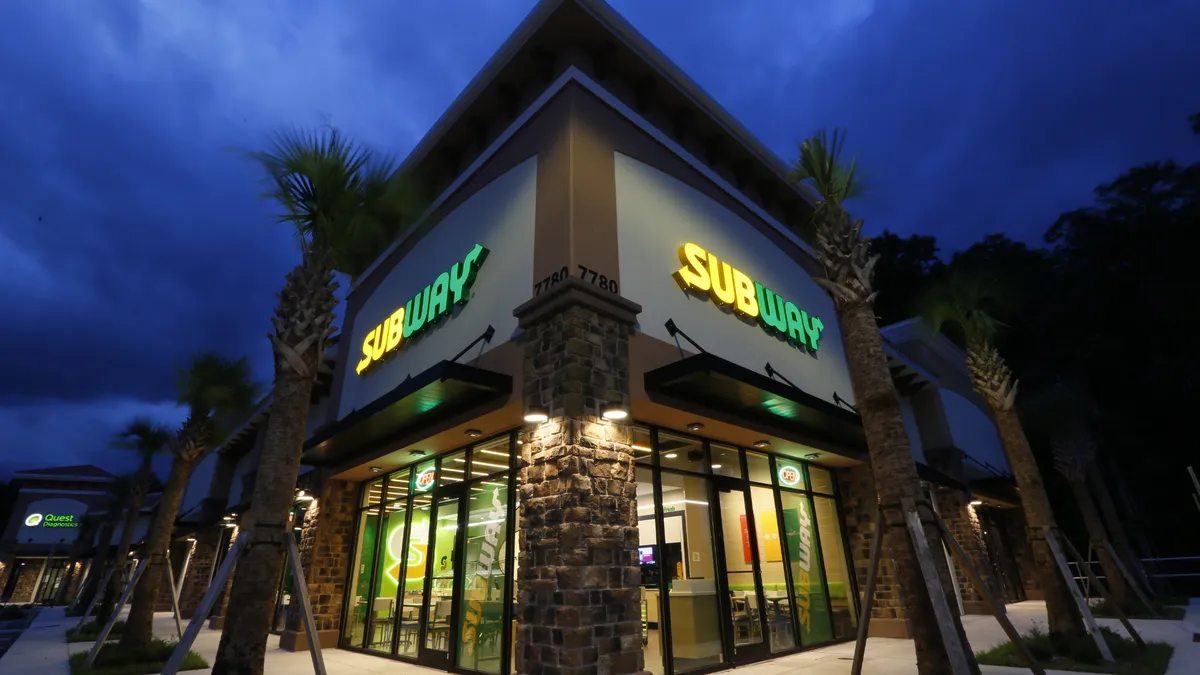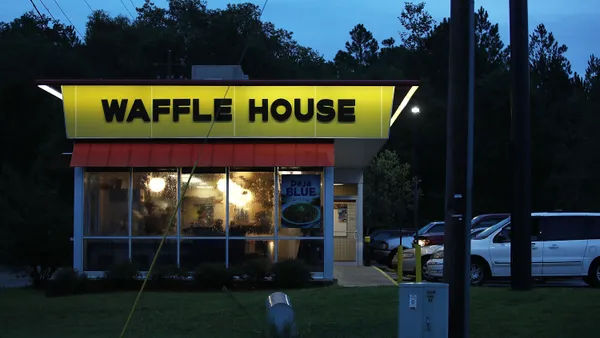Dive Brief:
- Subway announced Friday that it will partner with four of the leading third-party food delivery services: Grubhub, DoorDash, Uber Eats and Postmates, according to a company release. The sandwich chain’s foray into the booming delivery game will begin with 9,000 of its nearly 26,000 U.S. restaurants, which will offer delivery through Grubhub, DoorDash and Uber Eats. Subway will offer delivery through Postmates from up to 10,000 restaurant's within the service's coverage areas, according to a second announcement.
- By 2023, about 25% of restaurant sales — or $200 billion of the $800 billion of annual restaurant spending — will occur through digital ordering. Subway's new partnerships responds to this trend and puts it in direct competition with other fast food giants offering delivery, such as McDonald's, Burger King, Wendy's and Taco Bell.
- Like many restaurants using third-party delivery services, customers will not be able to use the sandwich chain's MyWay Rewards Program when having its sandwiches delivered. “We want to connect with consumers and give them the convenience of choice, whether it's in a customized, made-to-order sandwich or in how they get their meals,” Senior Director of Global Convenience Michael Lang said.
Dive Insight:
Burger King was onto something when it started testing delivery to U.S. customers in 2011. Today, every chain seems to be racing onto the delivery field, from McDonald’s (which had offered delivery in other countries since 2005), Wendy’s and White Castle, to KFC, Taco Bell and Panera. Subway might seem late to the game, but digital food delivery comprised about 6% of restaurant sales in 2017, according to analysts at Morgan Stanley. The investment banking company predicts consumers will spend $220 billion — more than seven times the current amount — in that space by 2022.
Subway has long provided delivery for catering but not for individual orders. Unlike most fast-food chains, Subway stores are entirely owned and operated by franchisees. A direct partnership with these third-party delivery services gives the restaurant chain access to valuable customer data and, to an extent, loyalty. This news arrives shortly after the company announced the closure of 500 U.S. stores, despite opening 1,000 internationally.
As technology improves and e-commerce becomes the norm, consumers are demanding online delivery options for much more than just pizza. While traditional phone calls still account for about half of delivery sales, tech companies like Grubhub have made it easy for restaurants big and small to offer online ordering. Subway showed restraint in waiting to partner, as Grubhub acquired online delivery pioneer Seamless in 2013, making it even more competitive. Likewise, Yelp’s delivery platform Eat24 no longer exists thanks to Grubhub, which shut it down after buying it for $287 million. Since Yum! Brands, which owns KFC, Taco Bell and delivery stalwart Pizza Hut, bought $200 million in Grubhub stock earlier this year, the landscape has only grown more competitive for fast food chains grappling with static sales, rising costs and a whole new world of trendy, inexpensive restaurant choices.
It’s interesting that the sandwich chain has opted against the unique delivery model of one of its rivals. Panera now employs some 10,000 dedicated delivery drivers, eschewing third-party platforms to keep revenues nearby. Sandwich competitor Jimmy John’s “freaky fast delivery” also lies at the core of its business model.
Some restaurant operators have reported losing 20% to 40% of revenue to third-party delivery services, though some stats point to higher check averages for orders that will serve more people or tack on last-minute indulgences. Still, operators aren’t necessarily sold on the benefits of third-party platforms. Many argue they forfeit quality control, and McDonald's, for example, is working to ensure to maintain the expected temperature and texture of their french fries
Meanwhile, fast-casual salad chain Sweetgreen has implemented a unique model in an effort to counteract these negatives. By building “outposts” in offices and buildings frequented by Sweetgreen customers, the brand keeps ordering in-house and sustains that essential customer relationship.
It’s unclear how Subway plans to support its franchisees, who have been vocal in their dissatisfaction with sales, marketing and leadership, in this new delivery-centric system. Perhaps meeting customers where they are — increasingly on mobile apps — will help boost sales and brighten its public image.












